What Is BSOD: Error 333 Registry Failure? Is It Real Or Fake?
BSOD: Error 333 Registry Failure is a nasty domain associated with online scam and rogueware virus. It is mostly brought to computers with help of unknown freeware and Trojan embedded on some compromised websites or open infected email messages. It is severe harmful to your computer safety and will lead you into traps that give big financial loss. Once it hijacks your web browsers, you will be rerouted to BSOD: Error 333 Registry Failure or other popup page whenever you go online. Adware like BSOD: Error 333 Registry Failure always cheats your with bogus security warning about detected virus, system errors or corrupted system files, for instance, “Warning! System May Have Detected Viruses on Your Computer”, ” Warning: Your Computer May Be Infected: System Detected 2 Potentially Malicious Viruses”, or “Warning: Your Personal Financial Information is Not Safe”. It attempts to cheat you get tech support from a phone call number it provides or install rogue antivirus to solve your problem. BSOD: Error 333 Registry Failure pop up spam not only got you scammed by illegal companies, but also put your privacy in danger.
You should never trust in such BSOD: Error 333 Registry Failure fake warning because it won’t help you to remove any virus, but causing more severe problems on your PC. If you cannot get rid of the adware timely, it may install additional spyware to your computer without your permission to increase the risk of your computer. If you view the pop up on your web browser, ignore the BSOD: Error 333 Registry Failure alert and take action to clean up your computer. Read the easy solutions here and get rid of the virus as soon as possible.
Solutions for BSOD: Error 333 Registry Failure Virus Removal (Remove BSOD: Error 333 Registry Failure Step-by-Step)
We provide three solutions on BSOD: Error 333 Registry Failure removal. You can choose the one that you can fully understand and handle on your own. But we still have some suggestions here:
Solution A is complicated, if you have enough PC techniques and rich experience on PC repair, you can try Solution A first; If you are not so great on your PC repair, do not use Solution A, or you may incautiously cause many errors and corruptions.
Solution B and Solutions C are easy methods that everyone can understand and execute. We recommend most of PC users to use these two solutions.
Solution A (Complicated Manual Removal method – only for Advanced and Experienced PC users with top skills)
Step 1. Change system folder settings to show all hidden files
Step 2. Seek and delete BSOD: Error 333 Registry Failure related files in hidden folders
Step 3. Seek and remove BSOD: Error 333 Registry Failure related registry files
Solution B (Best, easiest and most-used method)
Step 1. Uninstall BSOD: Error 333 Registry Failure related programs from your computer
Step 2. Remove BSOD: Error 333 Registry Failure plug-in, toolbar, add-on, extension from Microsoft Edge/ IE/Firefox/Chrome
Step 3. Scan your computer with SpyHunter to remove BSOD: Error 333 Registry Failure infection (Important Step)
Solution C (Effective method for removing stubborn malware )
Step 1. Run RegHunter to detect security bugs and fix corrupted/modified system files used by BSOD: Error 333 Registry Failure for re-infiltration (Important Step)
Step 2. Download and install Avast Internet Security 2015 to remove all hidden threats For Free
Step 3. Reset Microsoft Edge, Chrome, Firefox and IE to remove BSOD: Error 333 Registry Failure
Solution A – BSOD: Error 333 Registry Failure Manual Removal
Step 1. Change system folder settings to show all hidden files
On Windows 7 / Vista Computer
- Right-click the Windows Logo button and choose Open Windows Explorer.
- Click Organize and choose Folder and Search Options.
- Click the View tab, select Show hidden files and folders and then clear the checkbox for Hide protected system operating files.
- Click Yes on the warning and then click OK.
On Windows 8 Computer
- On your keyboard press the Windows + E keys.
- Click the View tab.
- Check File name extensions and Hidden items
Step 2. Seek and delete BSOD: Error 333 Registry Failure related files in hidden folders listed below:
(The files on your computer may appear with different name, if cannot find out the files listed below, do not delete any file, just use Solution B and Solution C)
%Temp%\[adware name]
%AppData%\[adware name]
%LocalAppData%\[adware name]
%LocalAppData%\[adware name].exe
%CommonAppData%\[adware name]
%AllUsersProfile%random.exe
Step 3. Seek and remove BSOD: Error 333 Registry Failure related registry files listed below:
1. Open Registry Editor first:
On Windows 7 / Vista Computer
- Click Start button
- Select Run button
- Type: regedit
- Click OK button
On Windows 8 Computer
- Press Win [Windows key] + R on your keyboard. This can be done either while at Windows 8 Start menu/Metro screen or on Windows 8 desktop
- At the dialog box that pops open, type regedit.exe and hit OK
- Once you hit OK, Windows UAC will prompt you to confirm you want to open Register Editor — hit “Yes”
2. Find out and remove all harmful registry files related with BSOD: Error 333 Registry Failure virus listed below:
(The registry files on your computer may appear with different name, if cannot find out the files listed below, do not delete any file, just use Solution B and Solution C)
HKEY_LOCAL_MACHINESOFTWAREsupWPM
HKEY_LOCAL_MACHINESYSTEMCurrentControlSetServicesWpm
HKEY_CURRENT_USERSoftwareMicrosoftInternet ExplorerMain “Default_Page_URL”
HKEY_LOCAL_Machine\Software\Classes\[adware name]
HKEY_CURRENT_USER\Software\Microsoft\Windows\CurrentVersion\Uninstall\[adware name]
Notes: Manual removal needs advanced PC skills, if you cannot find the BSOD: Error 333 Registry Failure files accurately, you may ruin your system for removing important system files. Therefore, if you are not a user with Advanced tech skills, it’s best to use Solution B or Solution C to solve your problem easily and safely.
Solution B – BSOD: Error 333 Registry Failure Easy Removal Method
Step 1. Uninstall BSOD: Error 333 Registry Failure related programs from your computer
On Windows 10 Computer
1. Click Start Menu on Win 10 screen, and click All apps.
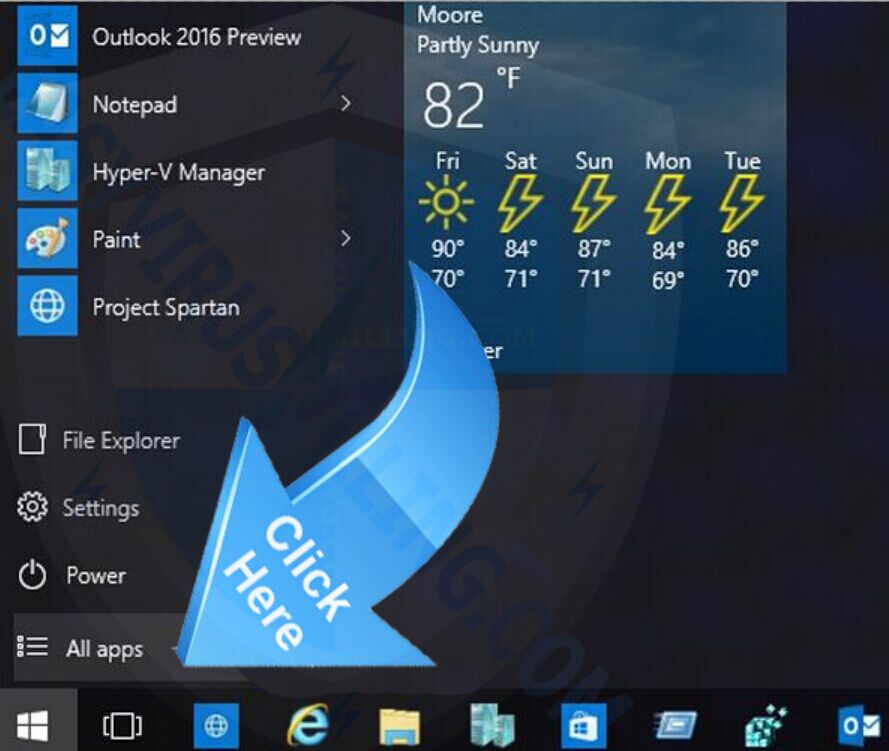
2. Now you can see all apps of your Win 10, find out the unwanted or suspicious program, then right-click it and select Uninstall.

On Windows 7 / Vista Computer
1. Click on the Start button to open your Start Menu, then Click Control Panel

2. In Control Panel, click on Uninstall a program under the Programs category
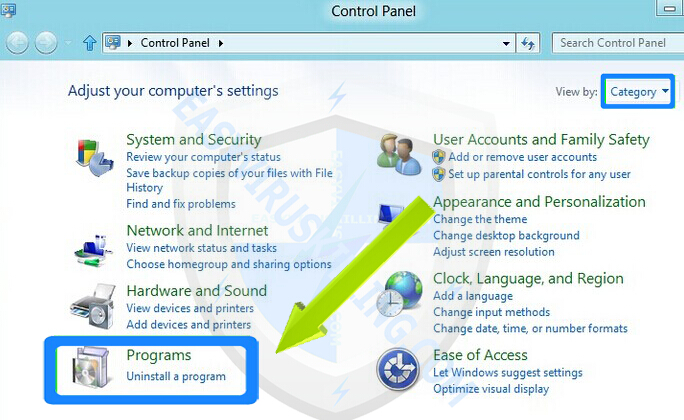
3. In the Programs and Features window, click Installed On to display the latest programs, scroll through the list to seek and uninstall BSOD: Error 333 Registry Failure and other unwanted and unfamiliar programs that look suspicious.
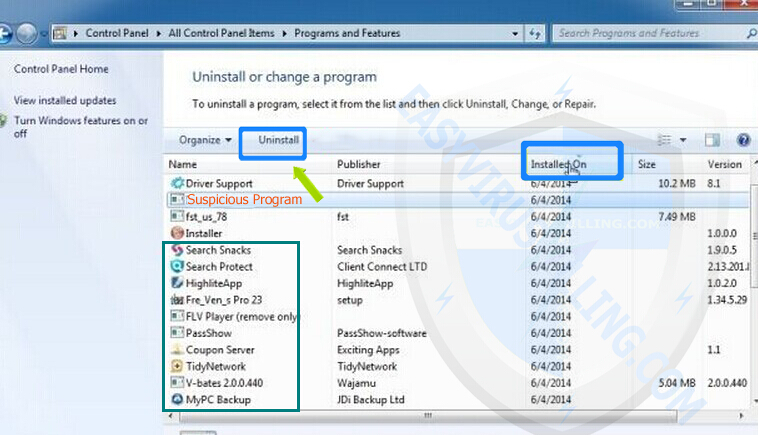
On Windows 8 Computer
1. Open the Settings Charm Bar by pressing Windows key  + I key on your keyboard at the same time, then click on the Control Panel option
+ I key on your keyboard at the same time, then click on the Control Panel option
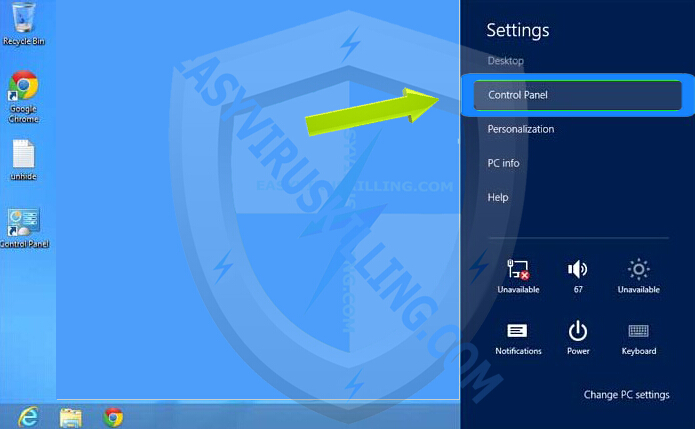
2. In category view, click on Uninstall a program under the Programs category
3. In the Programs and Features window, click Installed On to display the latest programs, scroll through the list to seek and uninstall BSOD: Error 333 Registry Failure and other unwanted and unfamiliar programs that look suspicious.
Step 2. Remove BSOD: Error 333 Registry Failure plug-in, toolbar, add-on, extension from Microsoft Edge/ Chrome/Firefox/IE
On Microsoft Edge
(Since Edge browser does not have extensions function now, what you need is just to reset homepage and search engine.)
1. Set your homepage page on Microsoft Edge to remove hijacker virus.
- Select More (…) on the address bar, then Settings
- Under Open with, select A specific page or pages
- select Custom to enter the URL of page you want to set as homepage
———————————————————————————————————————————————-
2 . Set your default search engine to remove search redirect virus.
- Select More (…) on the address bar, then Settings
- Click View advanced settings
- Click <Add new> under “Search in the address bar with”, then input the search engine you like
- Now select the search engine you like and click Add as default
On Chrome
- Click the Chrome menu
 on the browser toolbar.
on the browser toolbar. - Click Tools.
- Select Extensions.
- Click the trash can icon
 to delete BSOD: Error 333 Registry Failure extension.
to delete BSOD: Error 333 Registry Failure extension. - Make sure to remove all extensions you do not know or need.
- A confirmation dialog appears, click Remove.

On Firefox
- Click the menu button

 and choose Add-ons. The Add-ons Manager tab will open.
and choose Add-ons. The Add-ons Manager tab will open. - In the Add-ons Manager tab, select the Extensions panel.
- Make sure to remove all extensions you do not know or need.
- Click Disable or Remove button of BSOD: Error 333 Registry Failure.
- Click Restart now if it pops up.
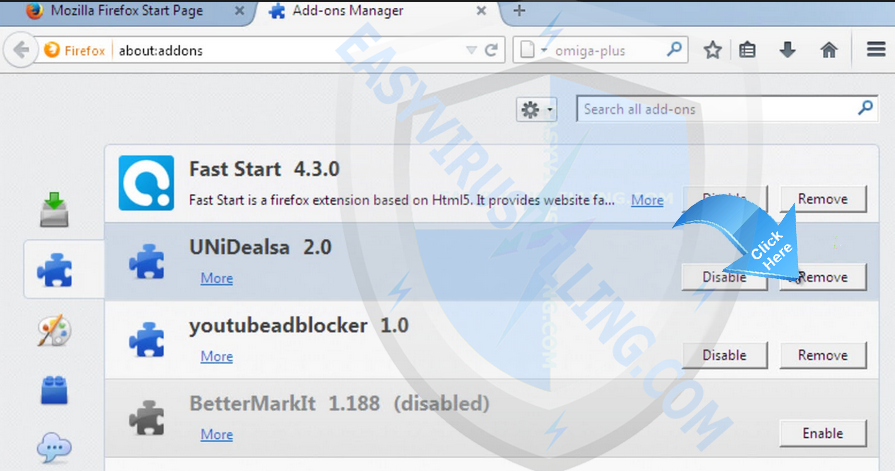
On Internet Explorer
- Open the IE, click the Tools button

, and then click Manage add-ons.
- Click Toolbars and Extensions on left side of the window., and then select BSOD: Error 333 Registry Failure
- Make sure to remove all BHO’s you do not know or need.
- If the add-on can be deleted, you’ll see the Remove option. Click Remove and then click Close. Otherwise click Disable button.

Step 3. Scan your computer with SpyHunter to remove BSOD: Error 333 Registry Failure infection (Important Step)
Uninstallation of program in Control Panel and removal of extensions / add-on from web browsers can help us remove parts of adware and malware, but nowadays most of computer threats such as BSOD: Error 333 Registry Failure are created with advanced technology and cannot be easily removed with regular methods, therefore we need to use top-class malware remover like SpyHunter to get rid of threats automatically. To completely remove BSOD: Error 333 Registry Failure, you should download and run SpyHunter antimalware to diagnose your computer and get rid of all threats related with the virus.
1. Click this link “Download SpyHunter“ or the blue button below to download SpyHunter Anti-Malware:
Tips: After SpyHunter is downloaded, your Chrome /Firefox /IE may display such fake security warning ” This type of file can harm your computer. Do you want to keep Download_Spyhunter-Installer.exe anyway?”, which is generated by virus to cheat you, please just ignore the fake warning and click “Keep” button.
(Notes – If you do not need it any more, please follow instructions on SpyHunter uninstall. SpyHunter`s free version provides unlimited free scans and detection. After it detects malicious files, processes and registry entries, you can follow the scan results to manually locate and remove them on your own; or to purchase its full version to automatically remove the virus with ease. Meanwhile, the full version of SpyHunter will offers you unlimited one-on-one professional help for any malware related issue by its official PC expert.)
2. Once downloaded, please double-click SpyHunter-Installer.exe to start the installation of SpyHunter.

3. When SpyHunter is installed, it will be run automatically, then click Scan Computer Now to detect BSOD: Error 333 Registry Failure related threats:
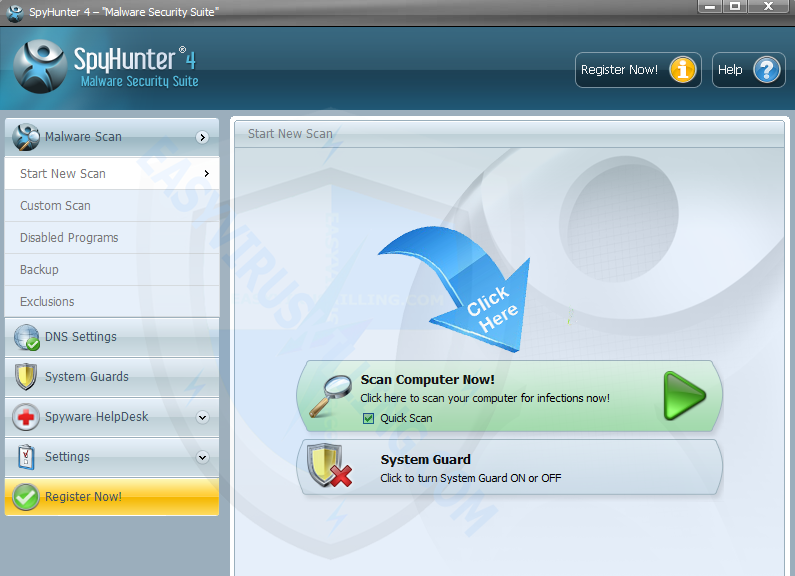
4. Once SpyHunter completes the scan, please click Fix Threats to get rid of BSOD: Error 333 Registry Failure.
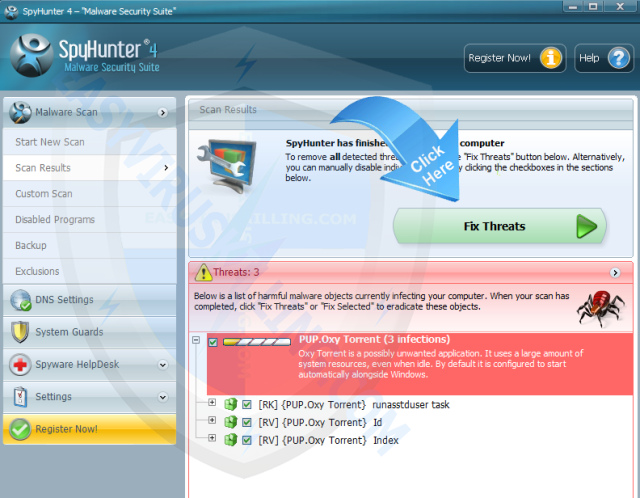
Note: According to users investigation, this solution can help 95% users remove virus like BSOD: Error 333 Registry Failure completely. But if it does not function on your computer, you need to complete all steps listed in Solution C. Continue now:
Solution C – BSOD: Error 333 Registry Failure Quick Removal Guideline
Step 1. Run RegHunter to detect security bugs and fix corrupted/modified system files used by BSOD: Error 333 Registry Failure for re-infiltration (Important Step)
If you tried Solution B and still unable to remove BSOD: Error 333 Registry Failure, then we are sure that some of your system files must been modified or damaged by the virus. With a deep investigation and test on stubborn malware such as BSOD: Error 333 Registry Failure, our tech team confirm that the security bugs and system files modified /corrupted by virus is the reason why the threats survive and reborn.
Most of spyware and malware infect Windows machines by making use of existed security bugs, and they alter or corrupt crucial system files with codes, that means malware like BSOD: Error 333 Registry Failure is able to execute installation or activation codes of its program repeatedly, no matter how many times you delete it from Control Panel or extensions. Therefore, if you do not detect and fix all security bugs and restore the corrupted / modified system files to default, BSOD: Error 333 Registry Failure can keep coming back. In such situation, it’s best to run RegHunter to fix security bugs and corrupted files, hindering the reborn and re-infiltration of BSOD: Error 333 Registry Failure.
1. Click this link “Download RegHunter” or the green button below to download RegHunter system optimizer:
Tips: After RegHunter is downloaded, your Chrome /Firefox /IE may display such fake security warning “This type of file can harm your computer. Do you want to keep Download_Reghunter-Installer.exe anyway?“, which is generated by virus to cheat you, please just ignore the fake warning and click “Keep” button.
Notes – If you do not need it any more, please follow instructions on RegHunter uninstall. RegHunter`s free version provides unlimited free scans and detection. After it detects corrupted registry files and system errors files, you can follow the scan results to manually replace them with healthy files copied from healthy PC on your own; or to purchase its full version to automatically fix the Registry and errors with ease. Meanwhile, the full version of RegHunter will offers you great features to optimize your system performance.)
2. Once downloaded, then double-click RegHunter-Installer.exe to start the installation of RegHunter.

3. When RegHunter is installed, it will be run automatically, then click Scan for Registry Errors Now! to detect files corrupted by BSOD: Error 333 Registry Failure:
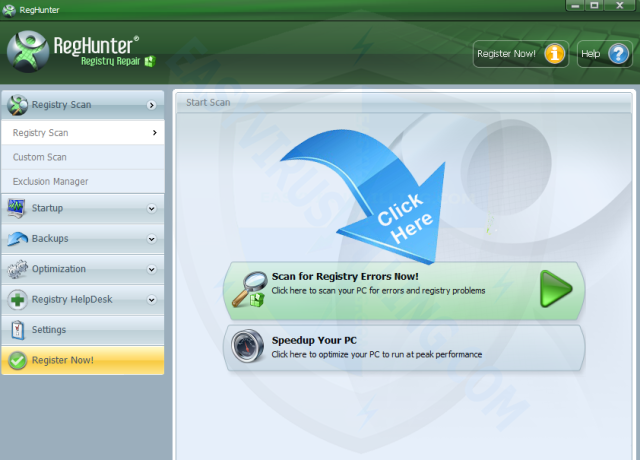
4. Once RegHunter completes the scan, please click Repair All Errors to solve security bugs related with BSOD: Error 333 Registry Failure.
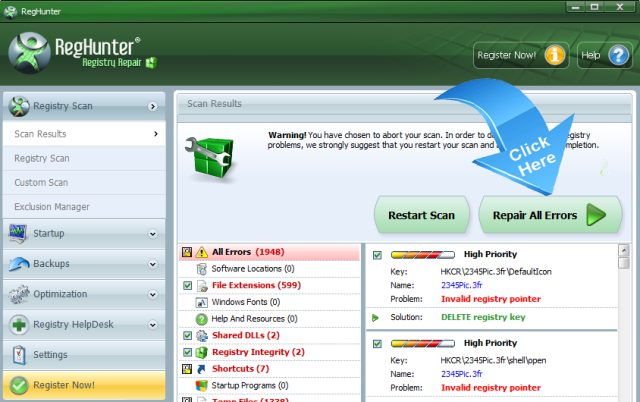
Step 2. Download and install Avast Internet Security 2015 to re-scan threats and protect your PC For Free
Avast Internet Security 2015 provides 60 Days free trail for you, it’s highly recommended to download and install it to re-scan your system and secure everything in your machine. You can uninstall it when you do not need it any more, it is 100% free. Click the button below to Download Free Avast Internet Security 2015 and enjoy 60 days of premium protection for free.

Step 3. Reset Microsoft Edge, Chrome, Firefox and IE to remove BSOD: Error 333 Registry Failure
– Reset Microsoft Edge
(We have reset homepage and search engine at solution 2, so we just need to clear up the cookies on Microsoft Edge)
1. Select More (…) on the address bar, then Settings:
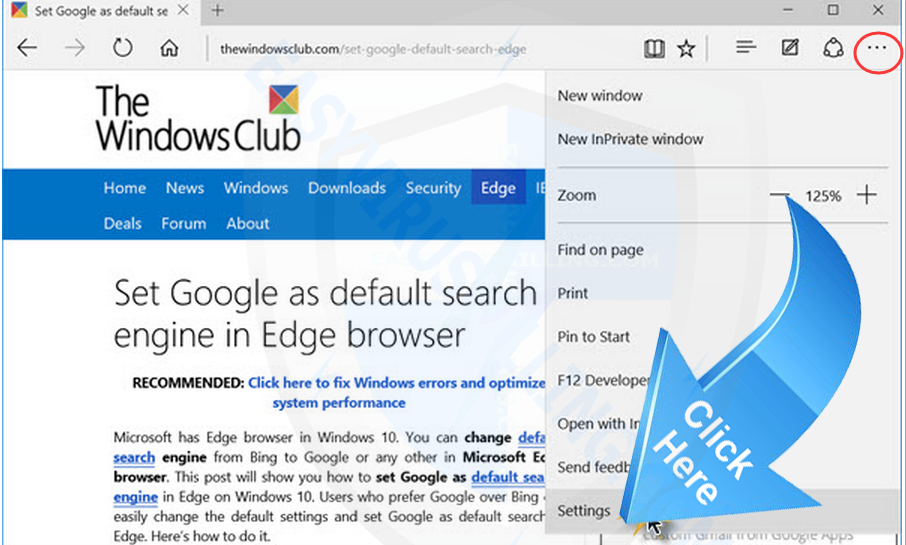
2. click “Choose what to clear”:
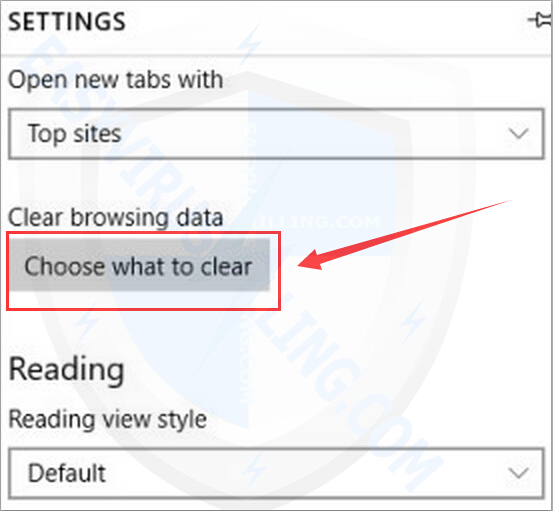
3. Check the first three options and then click Clear:
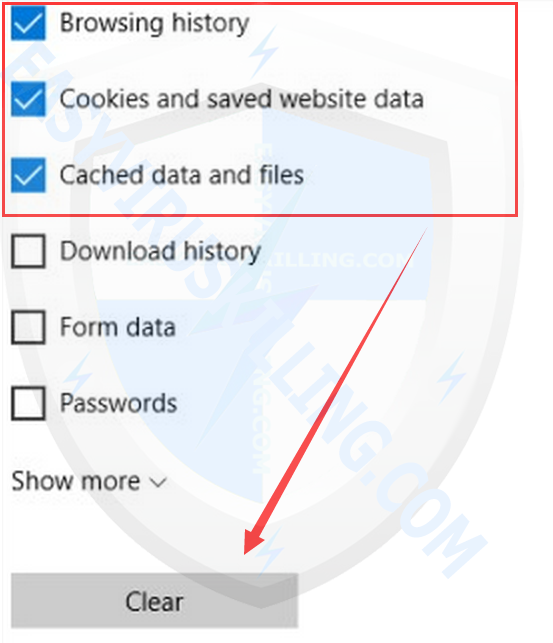
– Reset Chrome
1. Open Chrome, then click “Customize and control Google Chrome” button, and then click on Settings
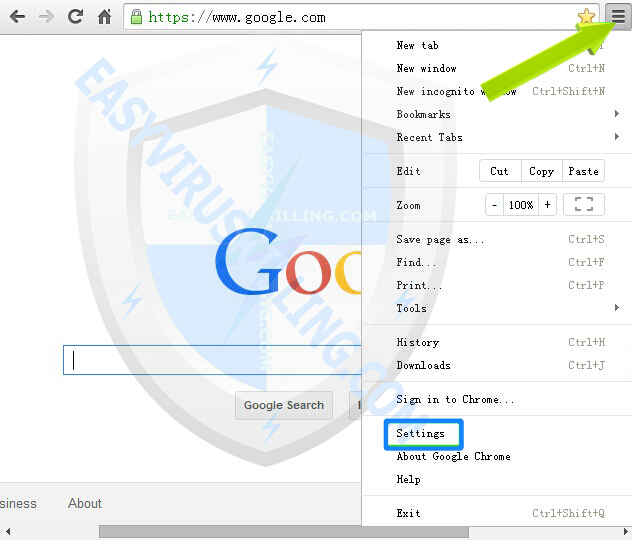
2. Under the Chrome Settings page, scroll down to the bottom, then click on Show advanced settings button
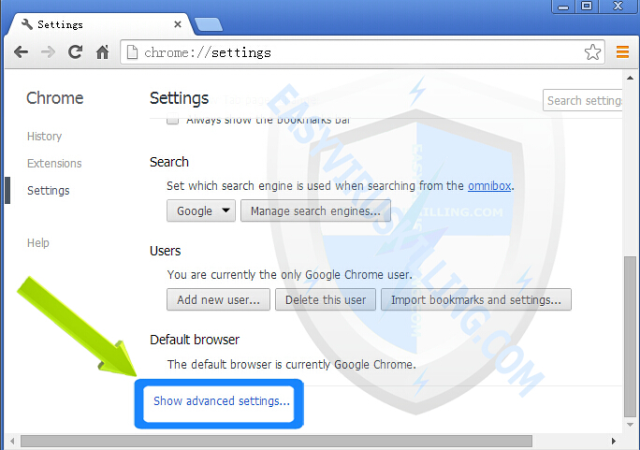
3. After clicking on Show advanced settings button, scroll down to the bottom and click on Reset browser settings button

4. A message box will pop up to inform that your browser settings will be restored to their original defaults, click Reset button when it appears:
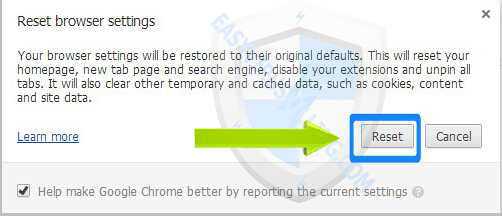
————————————————————————————————————————————————————————————————————–
– Reset Firefox
1. Open Firefox, then click on Firefox button, then Click on Help button, then Click on Troubleshooting Information

2. At the Troubleshooting Information page, click on Reset Firefox
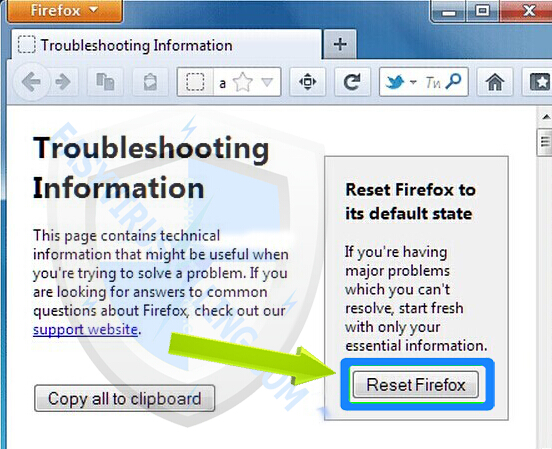
3. A message box will pop up to let you confirm that you want to reset Firefox to its initial state, click Reset Firefox button when it appears:

————————————————————————————————————————————————————————————————————–
– Reset Internet Explorer
1. Open Internet Explorer, then click on Tools, then click on Internet Options

2. On the Internet Options window: click on Advanced tab, then click Reset button

3. A message box will pop up to let you confirm that you want to reset all Internet Explorer Settings, click Reset button when it appears:
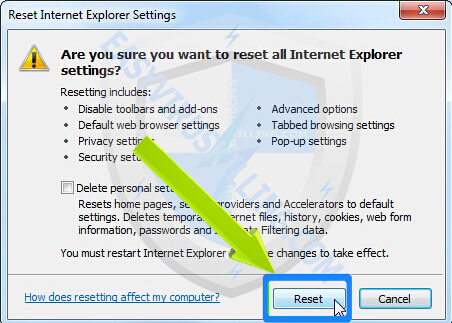
4. When the resetting process is done, you’ll see this message box, click Close
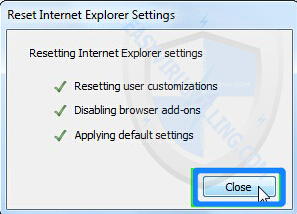
5. You’ll need to restart your Internet Explorer to complete the resetting process.

Friendly Reminder
If you can finish all the steps exactly, you must have got rid of the nasty BSOD: Error 333 Registry Failure virus as other PC users. Now you should learn some basic knowledge so that you will get viruses easily in the future . Please keep in mind, PC viruses are mainly disseminated through free software, emails, and porn websites, be carefully if you have any operations related with these things. First, always use Advanced or Custom Install while installing free software; secondly, do not click links or open attachments on emails unless you are sure that it is safe; thirdly, do not visit porn sites if you cannot assure its





